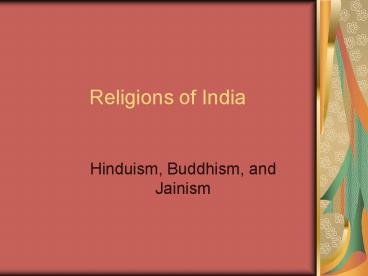Religions of India - PowerPoint PPT Presentation
1 / 24
Title:
Religions of India
Description:
Origins in the Vedas brought by the Aryans. Aryans had no written language. ... This is known as ahimsa protection of all humans, animals, insects, and plants. ... – PowerPoint PPT presentation
Number of Views:2852
Avg rating:3.0/5.0
Title: Religions of India
1
Religions of India
- Hinduism, Buddhism, and Jainism
2
Hinduism
- Origins in the Vedas brought by the Aryans.
- Aryans had no written language. Passed epics
down word of mouth. - Vedas Books of Knowledge
- Oldest is the Riga-Veda it is one of the oldest
religious text still used. - Vedas brought a complex social order to India
known as the varnas.
3
Varnas
- Aryans brought a complex social system with them.
- Kshatriyas warriors
- Brahmins priests
- Vaisyas merchants, artisans, and farmers.
- Sudras unskilled laborers and servants.
- Only warriors and priests were allowed to recite
the vedas.
4
Varnas
- Our a period of time, the rituals associated with
the vedas became more complex and secret. - By 500 BCE, the varnas became more rigid. The
varnas were subdivided into jati. - Jati were formed according to occupations.
- These formed the caste system.
5
Concept of Duty
- The vedas outlined the dharma or duties of the
male members of each jati. - Mahabharata and Bhagavad-Gita outlines the
concept. - Dharma means doing what is proper for ones age.
- This forms the foundation of Hinduism.
6
Hinduism
- Not founded on the teachings of one person.
- Religion of many deities.
- 800-400 BCE, a collection of writings and
philosophies were reflected in a text known as
the Upanishads. - The Upanishads tell of a universal spirit present
within all life. All living things have souls.
All souls are part of one eternal spirit The
Brahman Nerguna.
7
Hinduism
- To achieve unity with the Brahman Neguna, a
person must separate themselves from material
things. - Self-denial fasting and the practice of yoga
helps a person achieve a state of tranquility.
8
Hinduism Cycle of Rebirth
- Reincarnation soul passes through many
lifetimes to achieve oneness with the universe. - Cycle of rebirth is controlled by the karma. The
way you live your life will determine what you
will be in the next life. By doing good, you
become good, by doing evil, you become evil.
9
Cycle of Rebirth
- Out of that arose the attitude of non-violence
against all living things. This is known as
ahimsa protection of all humans, animals,
insects, and plants. - The cycle of rebirth continues until the person
achieves moksha a release from the pain and
suffering of rebirth.
10
Hindu Deities
- Brahma The Creator
- Vishnu The Preserver
- Siva The Destroyer
- Ganesha God of good fortune
11
Brahma
- The Creator
12
Vishnu
- The Preserver
13
Siva
- The Destroyer
14
Ganesha
- God of Good Fortune
15
Jainism
- A religious sect based upon Hinduism.
- Around 500 BCE, a Hindu teacher named Mahavira
rejected the strict caste system and sacrifice. - Jains believe in the sacredness of all life.
They use brooms to sweep their paths to avoid
stepping on insects. - Jains also refuse to farm for fear of killing
insects with plows.
16
Buddhism
- Siddharta Gautama founded Buddhism in the 5th
century BCE. - He was born and raised a kshatriya prince.
- He lived a sheltered life until one day when he
toured his estate. - Siddharta was shocked at the pain and suffering
he observed.
17
Buddhism
- At age 29, he left his wife and new born son to
find out why people suffered and how suffering
could be ended. - For 7 years, he lived as a hermit seeking the
answer through fasting and self-denial. - One day as he was meditating under a tree, he
gained an awareness that gave him the answer he
was looking for. - His followers began calling him Buddha or
enlightened one.
18
The Enlightened One
19
The Four Noble Truths
- All people suffer and know sorrow.
- People suffer because their desires bind them to
a cycle of rebirth. - People could end their suffering by eliminating
their desires. - One could eliminate their desires by following
the Eightfold Path.
20
Eightfold Path
- Know the truth.
- Resist evil.
- Say nothing to hurt others.
- Respect life.
- Work for the good of others.
- Free your mind of evil.
- Control your thoughts.
- Practice meditation.
21
Buddhism
- By avoiding extremes and following the Eightfold
Path, a person could attain nirvana or a state of
freedom from rebirth. - Nirvana is a place of extinction.
- In nirvana, a person becomes one with the
universe. - Buddha also rejected the caste system. He
believed that a persons place in life depended
on the person, not his birth status.
22
Spread of Buddhism
- Monks carried the religion to other parts of
Asia. - As the religion spread, disagreements broke out
among the followers. - Theravada S and SE Asia. Closely follows the
original teachings of the Buddha. - Mahayana China, Korea, and Japan. Followers
view Buddha as a savior and a divine person.
23
Spread of Buddhism
24
Hinduism and Buddhism
- Many deities
- Caste system
- Reincarnation
- Religious writings Upanishads
- Mainly in India
- No deities
- Rejection of caste system
- 4 Noble Truths
- Eightfold Path
- Reincarnation not necessary to achieve nirvana.
- Buddhism spread to other regions.

